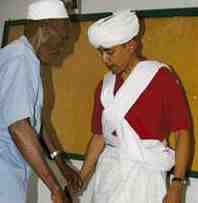More Dog Whistle Politics - Clinton Circulates Stupid Photo of Barak
/
Clintons Plumb Absurd Depths [HERE]
A silly photo of Barack Obama, dressed in some sort of traditional African garb, mysteriously made its way to the Drudge Report Web site yesterday. The photograph, which showed Obama wearing a turban and swaddled in white fabric, was taken in 2006, when the Illinois senator was on a tour of Africa.
But what did it mean? Was it a deliberately leaked smear image? Or an innocent snapshot of a guy humoring the locals by dressing up? The photograph, which might just as easily be seen as feminizing Obama as suggesting hidden Islamic sympathies, didn't yield many clues.
Even if it was meant as a smear image, the Obama in Africa picture was only slightly more sophisticated in its insinuations than an old Polaroid with horns and fangs drawn on it. By the end of the day, the only clear message from the strange episode is that whoever was spreading the image was not particularly sophisticated about the way images work in our new media world.
The fact that Obama appears to be wearing khaki pants and a polo shirt underneath the costume limits its power to suggest secret or devious meanings. The African fabric was an overlay on his very Western, very conventional outfit. Even the fabric looked light and diaphanous (as one might expect in a hot climate), suggesting it is a superficial, temporary addition to Obama's usual image.
An image such as this one also needs to circulate first among people inclined to believe the worst about its target. For a smear photograph to function properly, it must begin its journey into the body politic with what one might call a "Have you seen this?" phase. As it circulates under the radar, it gains a kind of credibility momentum, as people inclined to believe begin to think it is actual, documentary evidence of something that is being suppressed. The idea that it is being suppressed -- that it hasn't broken out to a larger audience -- actually helps it build credibility momentum.
If the image debuts to the larger world without that momentum, its smear message will be drowned out by a chorus of other story lines: Where did it come from? Who distributed it? Why did they do it? And that seemed to be case yesterday.
Digital photography and the Internet have also radically altered the potential power of most smear images. Although the age of the cellphone camera means that candidates must always be on guard against unwanted images, it also has diluted the power of any single unwanted image. We all know that we are all potentially on camera, and so we also cut one another some slack over bad hair days.
Along with the spread of digital photography, there has been an increasing sophistication in the public's ability to manipulate images. Once you know how to Photoshop your own snapshots, your trust in the credibility of political images is recalibrated. There's no evidence that this photograph is made up, that it is anything other than what it appears to be -- Obama looking a bit uncomfortable and a bit silly in a white wrap-around garment. But it arrives at a time when a habit of faith in photography is fading.
Photographs can still have devastating power in the play of politics. Who knows how much damage was done by an image of former presidential candidate John Kerry windsurfing? It certainly confirmed, for those inclined to believe it, a narrative of Kerry's elite tastes, distinguishing him from the other candidate, who liked to relax by clearing brush on his ranch.
That power, however, is a very unstable one. The Bush administration has been foiled time and time again in creating a meaningful arsenal of imagery in support of the Iraq war, a failure perhaps best seen in the "Mission Accomplished" images from the president's premature victory speech on an aircraft carrier in 2003.
Our current relation to photography is, perhaps, similar to how people who've been burned romantically relate to new suitors. There's suspicion, a longer period of testing, a lot of vetting and a lot of asking your friends what they think of your new special someone. That doesn't mean you can't still be seduced by an image, but it makes every image have to work harder to seal the deal.
"Obama in White" never really had a chance to work its power. If it was circulated by the Clinton camp, it may be yet one more example of a photograph biting its master's hand. Successful political photographs emerge when an audience finds an image it is already inclined to believe. This photograph seemed to be an image in search of an audience, and it got shot down before it could find one. One might see in this a parable of two political campaigns: One has an audience almost romantically inclined to accept its message, the other has a lot of messages that are looking for an audience.[MORE] and MORE]and [MORE]
On CNN Headline News, Goldberg compared Obama, FDR to Hitler

Time's Halperin: "Things McCain Can Do to Try to Beat Obama" include attacks on his race and name
CNN online poll echoes smears by asking if Obama "show[s] the proper patriotism"
Kondracke falsely claimed Obama would be "violating a promise" by "forgoing public financing ... between now and August"

McLaughlin echoes smear of Michelle Obama: "You don't think she's a black militant?"































































































































































































































































































